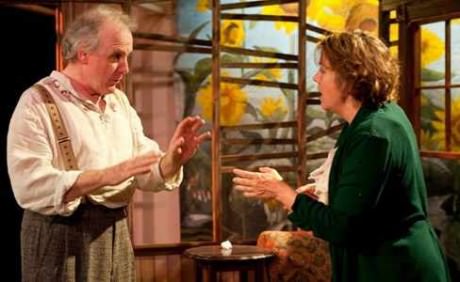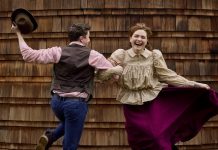Who doesn’t love a play about the theater?
A play-within-a-play, a set-within-a-set, and the juxtaposition of identity and personality between two characters are the primary set up for Tennessee Williams’ enigmatic, The Two-Character Play, currently on stage at Spooky Action Theater and directed by Richard Henrich.

To be clear there are four characters in this dynamic and poignant two-character play, but the lines are blurred in the strange interplay between recluse brother and sister Felice (David Bryan Jackson) and Clare (Lee Mikeska Gardner) and the two characters that perform in the play-within-a -play. (Also titled The Two-Character Play and whom share the same character names, Felice and Clare.)
What is real and what is an illusion are the questions you find yourself asking in The Two-Character Plays.
On the surface, this play concerns brother and sister actors on a theater tour in a small town. But it’s not that simple. The other players and the company manager have deserted them after weeks of working without salary, calling them “insane.” As the play begins the sibling’s find themselves trapped in a dilapidated Theatre all alone, performing a play that has no end about two Southern, agoraphobic siblings living in their childhood home after the murder and suicide of their parents. The theater is their home, and their home is a prison.
One of the last works by (1973, a.k.a. Out Cry) Tennessee Williams, The Two-Character Play, is also a memory play that underscores how family members can recall the same events and remember the details of them differently. This psychological labyrinth of a tale delves into the mental abyss of two individuals grasping at their last cling of life with a rational mind.
“To play with fear is to play fire,” says Felice. “Fire has limits – it stops having nothing to consume – but fear . . . Impossible.”
Fear. Anxiety. Panic. The paralyzing and debilitating effects of this devastating emotion and finding the strength to move beyond is a powerful through-line in Williams’ autobiographical journey of mental balance, emotional fragility, and the wandering of the imagination. This is not your typical Tennessee Williams play. This is art imitating life. Elements of his aesthetic and world view will be recognizable, but the rhythm is different.
This deeply personal play can be puzzling at times, but the intrigue serves the time well. The poetic language of Williams’s hypnotic realism envelops the audience in a dreamlike drama of moods and the broken world of trauma and loneliness. Written twenty-five years after A Streetcar Named Desire, and after a dark period in his life when he was confined for to a mental hospital, The Two-Character Play seems to reflect on the pained relationship the poetic innovator had with his older sister Rose who was confined to an institution. Tennessee Williams seemed to adore The Two-Character Play, referring to it as “my most beautiful play since Streetcar” and his “best play since Cat on a Hot Tin Roof … maybe better.” (That’s what he said.)
For those of you who don’t shy away from challenging work, this rarely performed curiosity is worth the look see if for nothing else than to see the talents of actors’ David Bryan Jackson and Helen Hayes Award winner Lee Mikeska Gardner, who possess potent stage presence and an undeniable chemistry. The shared history between the former couple who share a child adds texture and a natural muscle memory interaction to the layered portrayals of the nit-picking devotion and uncertainties they bring to Tennessee Williams’ two damaged characters.
These are two actors who listen intently to each other and gaze deep into each other’s eyes as if peering into the other’s soul. Jackson and Gardner are haunting in Felice and Clare’s intense quest to find an imaginative release from their turbulent realities. By creating new personas as performers in a play, their therapeutic escape never strays far from the neuroses of home despite their complicated efforts to do otherwise.
Garner is fascinating to observe with her tender and tough verbal play, and colorful in her interpretation of humor and tension within the dialogue. “Impossibility and necessity meet each other every day,” says Clare. Whether Clare is defending or deflecting, she is doing the best that she can to survive the retreats into her own mind, discount the voices that only she hears, and ignore the apparitions that haunt her. Lee Mikeska Garner vividly portrays being ‘confined’ and feeling the freeze as the atmospheric chill lowers on stage and the audience’s empathy rises.
David Bryan Jackson deftly balances a tense, wounded authority with Felice’s internal struggle, his conflicting alienating eccentricities, and his own ‘confusions.’
Recognizing the weakness in each other, there is a determination and vulnerability with The Two-Character Play characters. Felice and Clare share the unspoken camaraderie of hope . . . Or, is it desperation? Jackson and Gardner’s distinction with the four characters are clearly defined by their vocal inflections, individual sensitivities, and their ever shifting body language. Yet the characters they play find it difficult to differentiate themselves from their roles as they dip in and out of performance from reality from illusion.
Evocative intellectually, the familial chemistry of the sibling relationship can be strengthened, enhanced by pushing the rawness of vulnerability even further. I know that Felice and Clare are brother and sister because they say so with the dialogue, but what was missing for me was the full dimension and duality that come from a brother and sister, and the constant ‘challenge’ inherent with a sibling relationship. The compelling exchanges and bitter truths delivered are tense and dynamic, but I didn’t read the friction of competitive sibling rivalry that is such a natural existence within families. Nonetheless, what is complete is the powerful co-dependence the characters share, as they cling to one another like an emotional life preserver.
What also works are Henrich’s pacing, the blocking choreography, and the overall production design. The kinetic movement of Gardner and Jackson are a natural progression of thought, and Brian S. Allard’s accompanying mood changing lighting design is consistently effective. The set by designer JD Madsen is a striking, eyeful experience with the set-within-a-set where there is no one fixed environment to focus one’s attention (although the cardboard and paper mache sculpture “The Giant” and the come to life sunflowers are impressive focal points.) Felice and Clare’s odd assembled mix of wardrobe stylings by costume designer Kimberly Parkman are a winning look of eccentric fashion.
Spooky Action Theater should be highly commended for taking the artistic risk to present The Two-Character Play, and thanked for the casting coup pairing of Lee Mikeska Garner and David Bryan Jackson. According to Jackson, the play marks the first time in a decade that they’ve worked together on stage. There is indeed a ‘spooky action’ between the actors, the audience, and the play world of imagination created in The Two – Character Play and the convincing direction of Richard Henrich, who is also the Company’s Artistic Director. (The ‘Spooky Action’ Company name is based on Einstein’s “spooky action at a distance” quantum mechanics theory of the entanglement of synchronized atoms).
The never-ending plot or what’s actually happening in The Two-Character Play is anyone’s guess in this mystifying, tangled mental weave, and for me that is the beauty of the piece – an abstract expressionist portrait of ‘controlled’ chaos.
Running Time: 1 hour and 45 minutes, with a 15-minute intermission.
The Two-Character Play runs through October 27, 2013 at Spooky Action Theater at The Universalist National Memorial Church – 1810 16th Street, NW, in Washington, D.C. Purchase tickets online.





